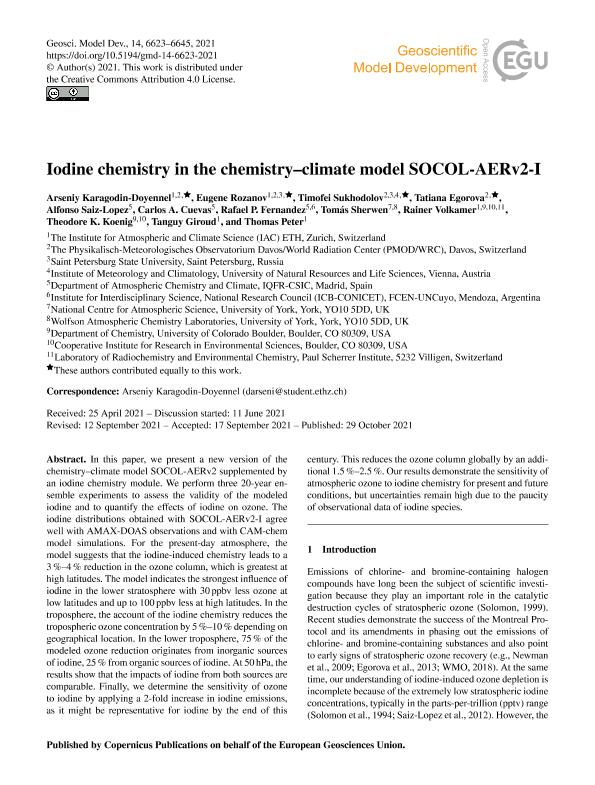Mostrar el registro sencillo del ítem
dc.contributor.author
Karagodin Doyennel, Arseniy
dc.contributor.author
Rozanov, Eugene
dc.contributor.author
Sukhodolov, Timofei
dc.contributor.author
Egorova, Tatiana
dc.contributor.author
Saiz López, Alfonso

dc.contributor.author
Cuevas, Carlos A.
dc.contributor.author
Fernandez, Rafael Pedro

dc.contributor.author
Sherwen, Tomás
dc.contributor.author
Volkamer, Rainer

dc.contributor.author
Koenig, Theodore K.
dc.contributor.author
Giroud, Tanguy
dc.contributor.author
Peter, Thomas
dc.date.available
2022-10-14T20:00:07Z
dc.date.issued
2021-10
dc.identifier.citation
Karagodin Doyennel, Arseniy; Rozanov, Eugene; Sukhodolov, Timofei; Egorova, Tatiana; Saiz López, Alfonso; et al.; Iodine chemistry in the chemistry-climate model SOCOL-AERv2-I; Copernicus Publications; Geoscientific Model Development; 14; 10; 10-2021; 6623-6645
dc.identifier.uri
http://hdl.handle.net/11336/173346
dc.description.abstract
In this paper, we present a new version of the chemistry-climate model SOCOL-AERv2 supplemented by an iodine chemistry module. We perform three 20-year ensemble experiments to assess the validity of the modeled iodine and to quantify the effects of iodine on ozone. The iodine distributions obtained with SOCOL-AERv2-I agree well with AMAX-DOAS observations and with CAM-chem model simulations. For the present-day atmosphere, the model suggests that the iodine-induced chemistry leads to a 3ĝ€¯%-4ĝ€¯% reduction in the ozone column, which is greatest at high latitudes. The model indicates the strongest influence of iodine in the lower stratosphere with 30ĝ€¯ppbv less ozone at low latitudes and up to 100ĝ€¯ppbv less at high latitudes. In the troposphere, the account of the iodine chemistry reduces the tropospheric ozone concentration by 5ĝ€¯%-10ĝ€¯% depending on geographical location. In the lower troposphere, 75ĝ€¯% of the modeled ozone reduction originates from inorganic sources of iodine, 25ĝ€¯% from organic sources of iodine. At 50ĝ€¯hPa, the results show that the impacts of iodine from both sources are comparable. Finally, we determine the sensitivity of ozone to iodine by applying a 2-fold increase in iodine emissions, as it might be representative for iodine by the end of this century. This reduces the ozone column globally by an additional 1.5ĝ€¯%-2.5ĝ€¯%. Our results demonstrate the sensitivity of atmospheric ozone to iodine chemistry for present and future conditions, but uncertainties remain high due to the paucity of observational data of iodine species.
dc.format
application/pdf
dc.language.iso
eng
dc.publisher
Copernicus Publications

dc.rights
info:eu-repo/semantics/openAccess
dc.rights.uri
https://creativecommons.org/licenses/by/2.5/ar/
dc.subject
SOCOL-AERv2-I
dc.subject
IODINE CHEMISTRY
dc.subject
STRATOSPHERIC OZONE DEPLETION
dc.subject.classification
Otras Ciencias de la Tierra y relacionadas con el Medio Ambiente

dc.subject.classification
Ciencias de la Tierra y relacionadas con el Medio Ambiente

dc.subject.classification
CIENCIAS NATURALES Y EXACTAS

dc.title
Iodine chemistry in the chemistry-climate model SOCOL-AERv2-I
dc.type
info:eu-repo/semantics/article
dc.type
info:ar-repo/semantics/artículo
dc.type
info:eu-repo/semantics/publishedVersion
dc.date.updated
2022-10-13T16:41:26Z
dc.identifier.eissn
1991-9603
dc.journal.volume
14
dc.journal.number
10
dc.journal.pagination
6623-6645
dc.journal.pais
Alemania

dc.journal.ciudad
Berlín
dc.description.fil
Fil: Karagodin Doyennel, Arseniy. The Institute for Atmospheric and Climate Science; Suiza. Physikalisch-Meteorologisches Observatorium Davos/World Radiation Center; Suiza
dc.description.fil
Fil: Rozanov, Eugene. The Institute for Atmospheric and Climate Science; Suiza. Physikalisch-Meteorologisches Observatorium Davos/World Radiation Center; Suiza. Saint Petersburg State University; Rusia
dc.description.fil
Fil: Sukhodolov, Timofei. Physikalisch-Meteorologisches Observatorium Davos/World Radiation Center; Suiza. Saint Petersburg State University; Rusia. University of Natural Resources and Life Sciences; Austria
dc.description.fil
Fil: Egorova, Tatiana. Physikalisch-Meteorologisches Observatorium Davos/World Radiation Center; Suiza
dc.description.fil
Fil: Saiz López, Alfonso. Consejo Superior de Investigaciones Científicas. Instituto de Química Física; España
dc.description.fil
Fil: Cuevas, Carlos A.. Consejo Superior de Investigaciones Científicas. Instituto de Química Física; España
dc.description.fil
Fil: Fernandez, Rafael Pedro. Consejo Nacional de Investigaciones Científicas y Técnicas. Centro Científico Tecnológico Conicet - Mendoza. Instituto Interdisciplinario de Ciencias Básicas. - Universidad Nacional de Cuyo. Instituto Interdisciplinario de Ciencias Básicas; Argentina. Consejo Superior de Investigaciones Científicas. Instituto de Química Física; España
dc.description.fil
Fil: Sherwen, Tomás. University of York; Reino Unido
dc.description.fil
Fil: Volkamer, Rainer. The Institute for Atmospheric and Climate Science ; Suiza. State University of Colorado at Boulder; Estados Unidos. Cooperative Institute for Research in Environmental Sciences; Estados Unidos. Paul Scherrer Institute; Suiza
dc.description.fil
Fil: Koenig, Theodore K.. State University of Colorado at Boulder; Estados Unidos. Cooperative Institute for Research in Environmental Sciences; Estados Unidos
dc.description.fil
Fil: Giroud, Tanguy. The Institute for Atmospheric and Climate Science; Suiza
dc.description.fil
Fil: Peter, Thomas. The Institute for Atmospheric and Climate Science; Suiza
dc.journal.title
Geoscientific Model Development
dc.relation.alternativeid
info:eu-repo/semantics/altIdentifier/url/https://gmd.copernicus.org/articles/14/6623/2021/
dc.relation.alternativeid
info:eu-repo/semantics/altIdentifier/doi/http://dx.doi.org/10.5194/gmd-14-6623-2021
Archivos asociados
